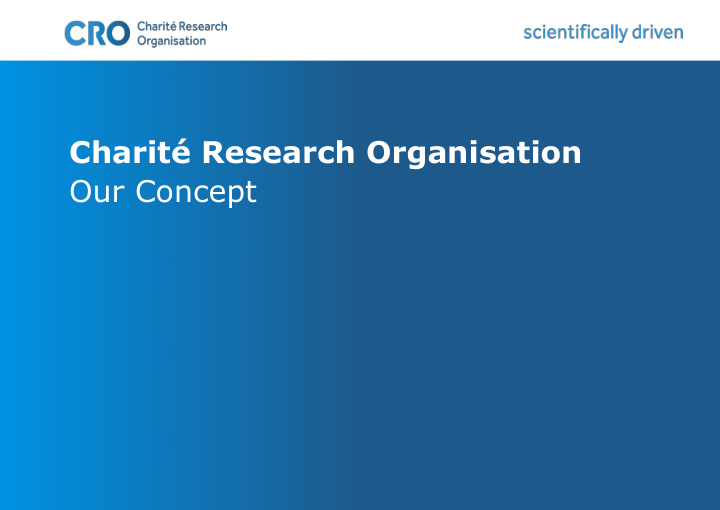



Charité Research Organisation Our Concept
Charité Research Organisation Charité owned | operationally independent | scientifically driven Experience Conducted more than 300 First Time in Human, Phase 1 and POC projects since launch in 2006. Pioneered FTIH and Phase 1 studies in patients. Key research areas Rheumatology, dermatology, gastroenterology, endocrinology, pulmonology, cardiology, Qualified Phase 1 and POC unit neurology, psychiatry, infectious diseases, ophthalmology, oncology. 30 beds (expanding to 70 in early 2018) with an additional out-patient facility. Access to patients, clinical expertise, biomarker, Study types imaging and diagnostic capabilities. First Time in Human, Phase 1, POC. Independent subsidiary of Charité – Includes biosimilar studies, imaging and Universitätsmedizin Berlin. methodology studies, blood and tissue sampling studies, pre-screening studies. Staffing Approximately 150 dedicated staff, including Access to accredited safety lab, ISO board certified physicians, nurses, lab certified biomarker labs, imaging facilities technicians, pharmacists, PMs, QMs, data and licensed GMP pharmacy. entry staff and independent QA.
CRO can provide a full service Partnered Internalised (University or external) Scientific & Regulatory Consultancy Routine Laboratory Analysis Project Management Biomarker Validation & Analysis Protocol Development GMP Pharmacy Ethical & Regulatory Submissions Monitoring Clinical Conduct Data Management Medical Writing Statistical Analysis Overseen by an ICH-GCP compliant QA / QM system
325 FTIH-PoC Projects to date From more than 50 industry sponsors Projects By Primary Area, June 2017 40 30 20 10 0
Charité Research Organisation FTIH-POC Success Stories Phase I in HV and Crohn’s Patients SAD study in n=64 HV patients & n=24 Crohn’s patients Completed with a single centre approach Phase I in Moderate-Severe Psoriasis Patients Multiple dose interaction study in n=21 moderate-severe psoriasis patients German-wide recruitment and enrolment completed in approx. 4 months Completed with single centre approach FTIH in RA Patients Study in n=92 RA patients across SAD i.v., SAD s.c. and MAD s.c. parts with imaging and biomarkers analysed locally Completed with a single centre approach Phase I in HVs and Asthma Patients Study with n=80 HVs across MAD and FE parts and n=54 mild-moderate asthma patients enrolled in approx. 2 months Completed with a single centre approach
Recruitment Case Study Phase I Psoriasis Study Population Screened Randomised Completed Psoriasis Area Assessments 156 61 58 Dermatology PASI, psoriasis target lesion score Recruitment Strategy Single-Centre 3 drop-outs n=61 psoriasis patients Database & online in 6 groups marketing Total Enrolment Study Duration Duration 4 weeks SCR 40 out of 61 patients [66%] randomized with Approximately 8 months 12 to 17 weeks a PASI score of 4 or higher on Day -1 of active enrolment across treatment + FUP Average PASI score of 8,3 on Day -1 for all groups randomised patients Average recruitment rate of 8 per month
CRO Centres of Excellence Approach Patient recruitment via dedicated team using database and advertising Clinics provide Clinicians share access expertise Methodological and scientific Access to support from key technologies therapeutic area such as MRI experts Phase I/II unit and team Scientists utilise Access to specialist biomarker research research and laboratory capabilities
CRO Centres of Excellence Clinical and scientific support Imaging with central scoring ISO certified Immunological across multiple disciplines services: MRI, US, FOI, X-Ray, Study Laboratory (ISL) CT, PET Key examples include Off the shelf assays, transfer dermatology and rheumatology and validation of sponsor assays, research laboratory Prof. Dr. med. Prof. Dr. med. Prof. Dr. med. Gerd Burmester Marina Backhaus Hans-Dieter Volk PD Dr. med. PD Dr. Gerald Grütz Kay-Geert Hermann Prof. Dr. med. Gerd Burmester PD Dr. med. Kay-Geert Hermann Prof. Dr. med. Hans-Dieter Volk
Feasibility Process Determining the number of potentially eligible subjects Prevalence of rheumatoid Prevalence arthritis: approximately 0.5% What is the general indication specific prevalence? Population of Berlin/Germany: Subset of Population 3.5/81 million RA patients in Berlin/Germany: Based on the prevalence what is the 3.5/81 million x 0.5% = subset of the Berlin/German population we 17,500/405,000 can target? Percentage of RA patients Potentially Eligible Subjects represented by inc./exc. criteria: 30% (for example) Based on experts’ judgement what Potentially eligible RA patients percentage of this subset is represented in Berlin/Germany: by the defined inclusion/exclusion criteria? 17,500/405,000 x 30% = 5,250/121,500
CRO Recruitment Approach Have the resources Financially + + Appeal directly to treat the patient compensate the to the patient with utmost respect patient appropriately
Innovation: A National Single Centre One centre | German-wide Sjögren Patient Recruitment 11 patients from Berlin 16 from the rest of Germany 250 100 54 telephone information screenings contacts sessions 21 Google 6 Referral 27 enrolled patients Study VAY736X2201 recruitment Planned Screening 80 Number of Subjects Actual Screening 60 Planned treated Actual treated 40 20 European Clinical Research Review | S. Gadola, S. Oliver | 25 May 2015 VAY736 in RA, pSS and PV 0 May Aug Jul Sep Nov Jan Mar Jun
Innovation: Pre-Screening Studies n=244 asthma patients identified and pre-screened against Pre-screening study key study inc./exc. criteria before and during conduct of HV part approved by local ethics Core block of patients n=108 considered to be “probably” eligible for main study identified to push to main study Ultimately n=98 retained n=98 entered into main study screening for main study screening n=54 randomised in just over 2 months in n=54 randomised 2 parallel cohorts of 27
CRO Centres of Excellence “Working with Charité Research Organisation allows me to contribute both scientifically and practically. We have been able to incorporate innovative MRI imaging techniques in early phase RA studies – such as Dynamic Contrast Enhanced MRI – and also explore the potential for MRI to be utilised in other indications such as OA and SpA .” PD Dr. med. Kay-Geert Hermann Charité Radiology Institute
Charité Research Organisation GmbH Charitéplatz 1 10117 Berlin, Germany enquiries@charite-research.org www.charite-research.org
Recommend
More recommend